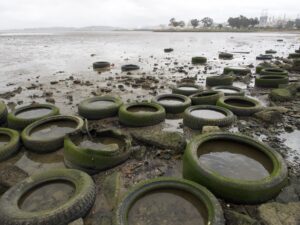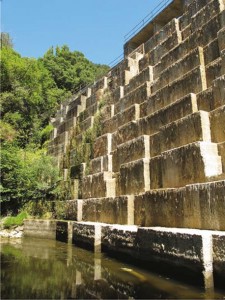It’s a pretty sorry sight to see a threatened steelhead trout flopping around without enough water.
But that’s what’s happening in San Francisquito Creek in Palo Alto, where the creek is drying out well before it should this year and jeopardizing the the most viable remaining native steelhead trout population in the Bay Area.
“The fish are exposed and people are seeing them because the water is clear and low,” said Matt Stoecker, the director of Beyond Searsville Dam. “People heard them first, they heard the flopping.”
Creekside resident Doug Rundle captured this video of the steelhead in the creek in late February, and Stoecker has been monitoring their progress as they attempt to make their way to upstream spawning waters.
Stoecker said low rainfall this year has left San Francisquito Creek parched, and upstream diversions, including the controversial presence of Searsville Dam at Stanford University, are certainly not helping matters. Beyond Searsville Dam is a local nonprofit whose goal is to dismantle the 65-foot dam, built in 1892, in order to restore natural flow conditions to the watershed for the benefit of steelhead and other riparian species. The group says the dam prevents the steelhead from migrating to almost 20 miles of habitat upstream that was historically accessible.
“San Francisquito Creek has one of the last runs of steelhead in the South Bay, and this is the last chance for rebuilding and reviving the population,” Stoecker said.
Last year, Stoecker’s group observed a pair of steelhead that died in a dried up stream, and it’s concerned a similar scenario may play out in the coming weeks. Another problem is poaching. As the fish are exposed, they have little protection from people who can easily pick them out of the water.
“I know of at least one fish that has been poached,” Stoecker said.

Steelhead trout, also known as rainbow trout, can spawn multiple times, provided stream flows are adequate, and return to original hatching grounds, like salmon. They can weigh in at as much as 55 pounds and grow up to 45-inches in length, though the average size is much smaller. Efforts to list them as an endangered species along segments of the West Coast date back to 1994.
“They’re just struggling to hold on. They’re a very resilient fish and will keep coming back, but they can’t get above the Searsville Dam where they need to be,” Stoecker said.
Stanford University has started a study on what to do about Searsville Dam, which includes as one option removal. While some argue that a dam removal would destroy habitat used by birds and bats, the outcome of a recent National Marine Fisheries Service investigation into whether the university is violating the Endangered Species Act for illegal “take” of steelhead trout, may have turned the debate on the dam’s ecological impact.
Here’s some underwater footage of the fish.
Alison Hawkes is the online editor for Bay Nature.




